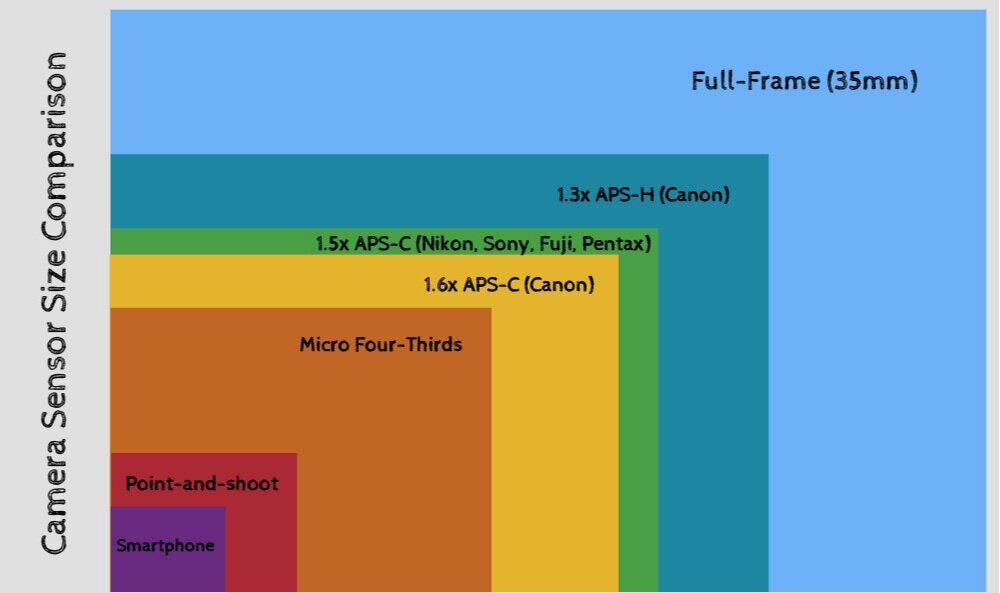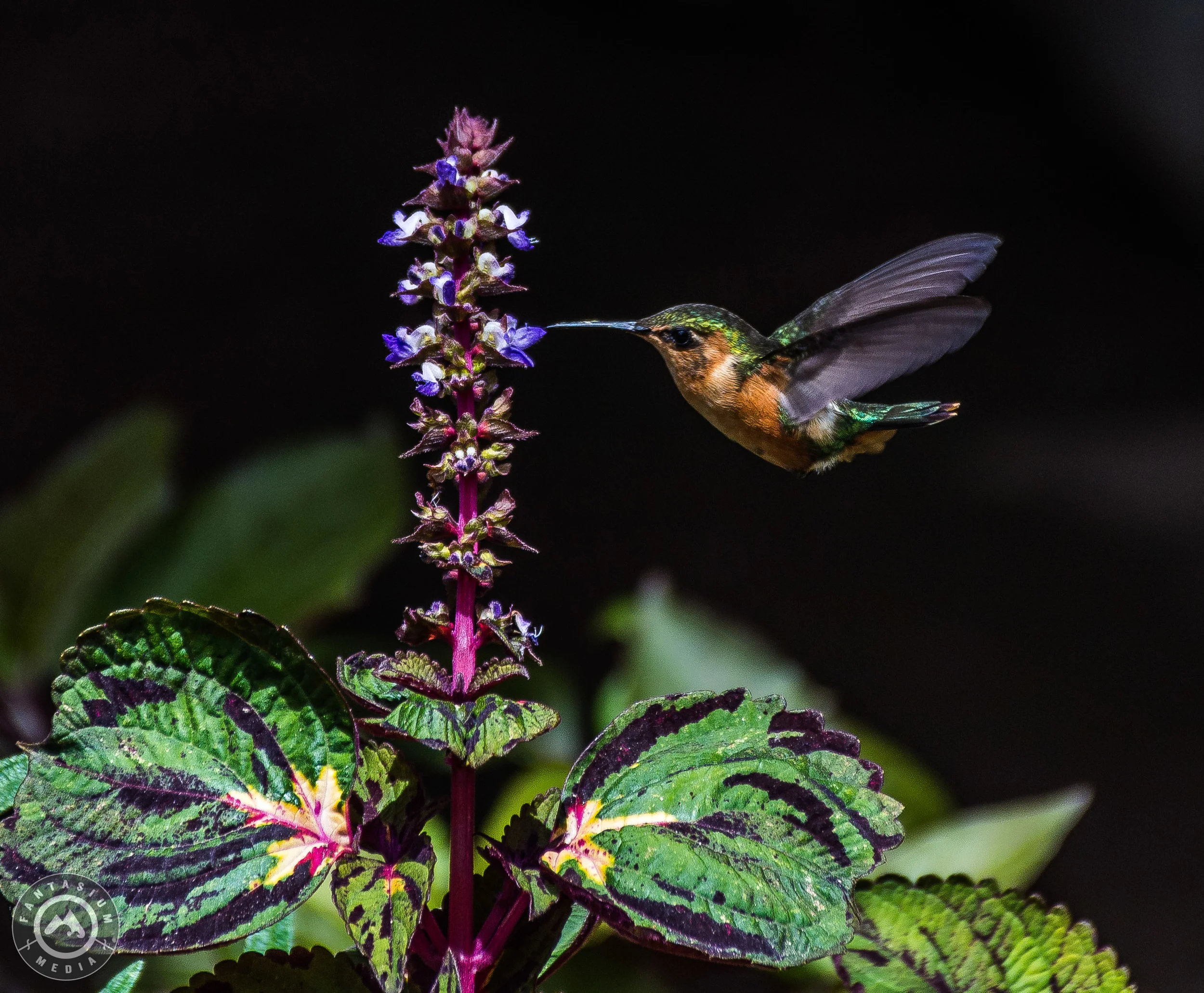Photography 101: Full Frame vs. Crop Sensor Cameras
Many times when you walk into a photography store looking for a new camera the first thing the rep behind the counter might ask you is, “Are you looking for a full frame or crop sensor camera?” You might also see information online strongly recommending full frame cameras for one reason or another. If you’re not sure on the exact difference between the two this can get confusing and also frustrating, especially when one compares the price of full frame cameras to crop sensor cameras. Oftentimes this stigma towards full frame cameras is misplaced. Let’s dive into the difference between the two, what their uses are, and why you might consider one over the other.
What is a sensor and what does it do?
First to understand why it’s important to differentiate between full frame and crop sensors, we need to understand what a sensor does and why size is important - without getting into too many highly technical details.
Put simply, a sensor “reads” the light in the scene you a photographing - similar to the way your eyes interpret light - and inputs the data that it takes in through the lens into a digital format and writes it to your memory card. The data is then transformed into a format that you can easily view - a photograph.
Sensors are made up of millions of small points that interpret the photograph’s scene called megapixels. At a high level, the more megapixels, the more data and detail the camera can pick up when taking a picture. That’s why you see camera manufacturer’s constantly increasing the megapixel count in their sensors. This isn’t true 100% of the time, but in general, if a sensor has more megapixels, it can create a higher quality image.
In summary, a sensor picks up the light from a scene you would like to take a picture of. The bigger the sensor the larger the scene it can capture, and the more megapixels on the sensor, the more data (detail) the image will contain.
So now that we know how sensors work and what their function is in a camera, what’s the difference between a full frame and a crop frame sensor?
Full Frame & Crop Sensors Explained
As you might have guessed, a “full frame” sensor is bigger than a crop sensor. But it’s also “smaller” than a medium format. So what exactly does full frame mean?
Full frame is a reference to 35mm film. 35mm film cameras are able to capture a certain area and transpose that onto a roll of 35mm (don’t worry about why it’s called 35mm - that’s a whole different discussion that frankly doesn’t make a whole lot of sense in the modern era!). Full frame sensors capture that same image area and transpose it into a digital image.
Crop sensors capture a smaller frame than a full frame sensor of course! There are tons of crop factors out there, and lots of manufacturers have their own specific size they use for their crop sensors. A crop sensor’s size is designated by its “crop factor”, which is essentially how much smaller in proportion it is to a full frame sensor.
Full Frame Sensor Qualities
So now that we know why certain sensors are designated as full frame, what is with all of the craze about using one vs. using a crop sensor camera? There are undoubtedly several benefits that are important to note when it comes to full frame cameras.
Wider angle of view. The most obvious perk of using a full frame camera is that your angle of view is increased. Full frame cameras can capture more of a scene, which has huge advantages in most - but not all - types of photography. Many new cameras these days offer the ability to toggle in between full frame / crop shooting mode in camera.
Better low light / ISO performance. Because the sensor is has more surface area it means that the manufacturer can include more of the little components that pick up light - pixels. If you remember, more pixels also means more detail. There’s a caveat here though. There is a point of diminishing return for pixels. Sensors have remained the same size, but pixels have gotten smaller. The smaller the pixel component on the sensor, the less light that pixel is able to pick up. That’s why cameras like the 24MP Sony A7 III have better low light performance than their 61MP cousin. The higher megapixel camera can capture more fine details, but it’s pixels are smaller so they can be packed into the same surface area, which degrades their light gathering properties.
Depth of field. The sensor size itself doesn’t actually affect the depth of field in an image, but because of the difference in the way that the full frame camera captures the scene using a given lens (more on this below), it gives the appearance of providing a shallower depth of field.
The camera uses the “real” focal length of the lens”. When you attach a lens to a full frame sensor, the focal lengths (i.e. 35mm, 50mm, 85mm, etc) that the lens is set to is the actual focal length that the camera will use to capture the image. When using a crop sensor, the focal length is multiplied by the crop factor of that sensor. For example, a 100mm lens on a crop sensor APS-C sensor would be multiplied by 1.5x, giving it an effective focal length of 150mm.
Crop Sensor Qualities
Cost. The sensors are smaller, which means that it requires less materials to produce. Crop sensor cameras are cheaper than full frame, often dramatically so. The lenses are also drastically cheaper!
Size. Shrinking that sensor automatically makes it a crop sensor, but it also means you can pack it into a small device! Smartphones are a great example - those sensors are super tiny, but they still can capture great image quality. Crop sensor cameras will always be smaller, which can be a huge factor in deciding the type of camera you will purchase.
Telephoto photography. Remember the crop factor that extends the focal length of lenses? This can be an advantage when using zoom lenses because it effectively extends your lens. This is often, but not always and advantage to full frame cameras. For example, the Sony a6000 crop series boasts sensor sizes of 24.2 MP, which is top of the line for a APS-C sensor. However, the Sony A7R IV can switch to a crop mode in camera, which allows the user to shoot at 26.2 MP. Furthermore, if you were to crop down a full frame 61MP image from the A7R IV in post processing, it would be equivalent to the 26.2 MP image that you could capture using the crop mode in the camera. It’s a tad confusing, but the moral of the story is it’s important to recognize the trade offs when it comes to sensors!
Which one is right for you?
In general, if you can afford it, I would always recommend a full frame camera. The body and the lenses will cost you a pretty penny, but if your budget allows, you’ll get more out of a full frame camera than you would a crop sensor camera. That being said, crop sensor cameras are amazing pieces of technology. They are compact and far less expensive than full frame cameras. For beginners who are looking to stick to a budget, I can’t recommend crop sensor cameras enough. I shot with a crop sensor camera for the first five years of my photography journey, and probably wouldn’t have gone in on an upgrade if I didn’t get the amazing deal on a full frame camera that I did.
In summary, if you can afford it, go full frame, but don’t be discouraged at going with a crop sensor camera.
Below are some of our recommendations for our favorite cameras that we have used.
Note: I was not compensated in any way for the following recommendations and opinions.
Entry Level: Those New to Photography
Nikon D3000 series, Canon Rebel series, Sony a6000 series
I think it’s safe to say that these three models have the entry level market pinned down, and with good reason. Each one of these cameras sports outstanding features and technology that will make them easy for someone upgrading from a cell phone or a point and shoot camera to use right out of the box. They all also can be purchased as a kit that includes a close to midrange lens as well as a zoom lens. It’s important that we don’t overlook the fact that these are powerful machines, even at the entry level. Each of these crop sensor models offers full manual shooting and advanced features, which allows beginning photographers to grow with their camera and can even provide advanced shooters and professionals with a solid backup camera or even main camera, as long as they are paired with the correct lens.
Midrange: Photographers Looking to Upgrade From Their First Camera
Nikon D7000 Series, Canon EOS 80 or 90D, Sony A6400 - A6600
When a photographer is ready to upgrade from their first camera it’s usually because they have started (attempting) to shoot things that they just can’t capture the way they want with their current camera. Maybe they are looking to shoot wildlife and their FPS isn’t fast enough, or they have been shooting landscape and just aren’t getting the detail they want from their base level sensor. Each one of these models with a lens will break the $1000 price point, and with good reason. We’re still in crop sensor territory, but besides that these are semi-professional cameras that are suited to a myriad of different shooting types. Add in some top of the line lenses to one of these bad boys and you’ve got yourself a mean shooting machine.
Prosumer: Shooters Who Know Their Stuff
Nikon D780, Canon EOS R, Canon EOS 6D Mark II, Sony A7R II, Sony A7R III
Now we’re getting into the full frame lineup of premium cameras. Once you break this barrier you’re looking at powerful cameras that can meet the needs of both serious hobbyists and professionals alike. These will all have top of the line technology paired with extensive camera features and high end lenses. The jump from crop sensors to full frame is usually worth it for most photographers when looking at one of these cameras or another model that is similarly equipped.
Professional: The Best of the Best
Nikon D850, Canon EOS 5D IV, Sony A7R IV, Nikon Z7
These cameras mean business. Equipped with the best of the best technology and a price point to match, this lineup is geared towards professionals who need top of the line performance from their cameras with each and every shot. All of these are full frame cameras and can be paired with top of the line lenses to serve every need with crispness, clarity, and quality.












